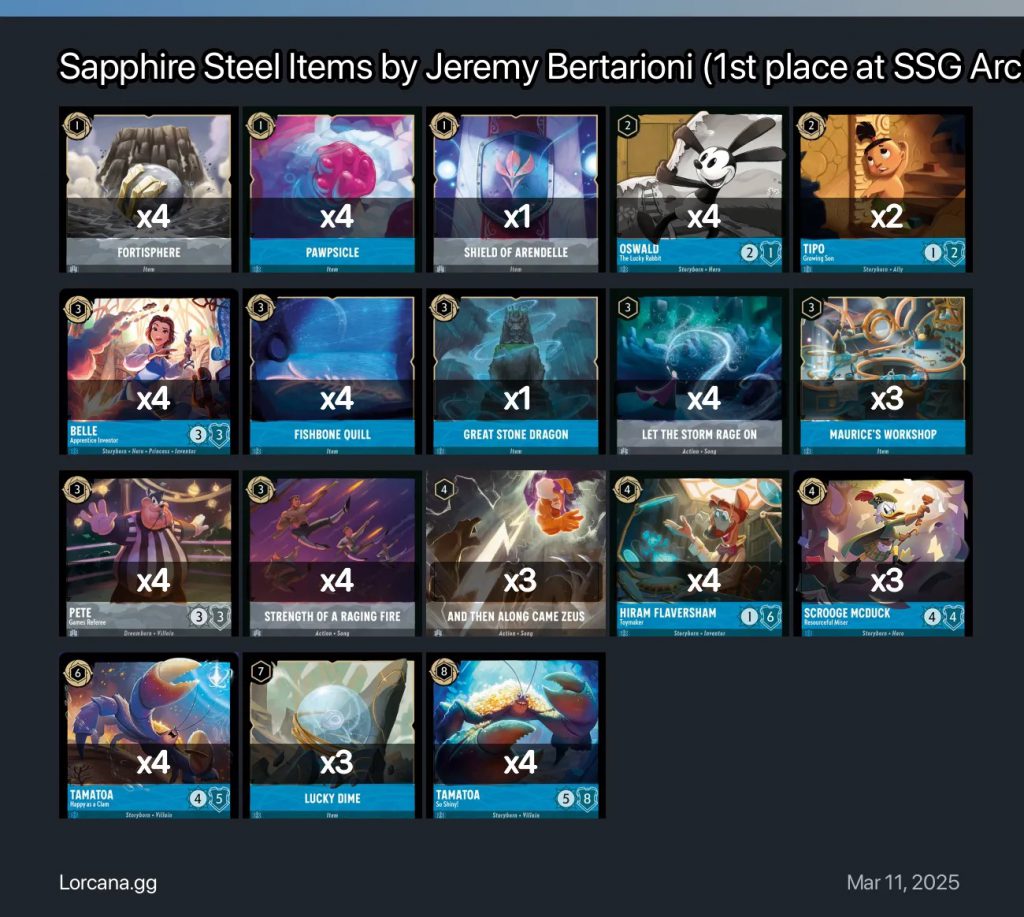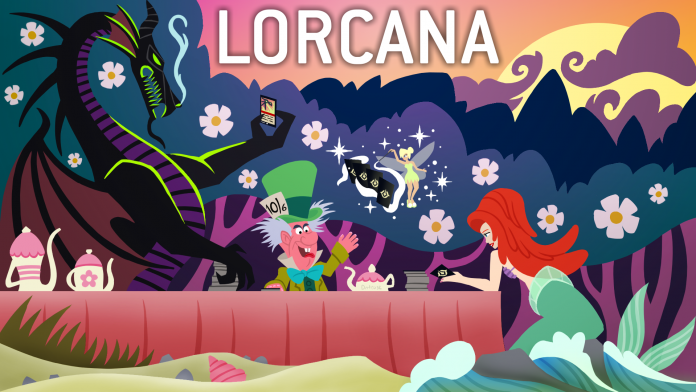Since this is a casual play Disney Lorcana column, I don’t often wade into the waters of meta-tomfoolery but I am at least somewhat interested in what high-level players and aspirational sweats are doing with the current deckbuilding options. And I especially like to take a look at how new sets impact the competitive scene- it demonstrates how the game has evolved and grown over time while also giving us a picture of where the game is from a design standpoint. Seeing what top players are doing with their builds can be quite compelling, even when I’m out here running my dinky Hercules deck that likely wouldn’t stand a chance at a meta-heavy event.
In case you missed the news, that meta is topsy-turvy right now. The new set sort of went bananas on Sapphire Steel, and players are getting good results from builds that seem to be focused primarily on a WTF possibly broken common, Belle – Apprentice Inventor. There are many variations out there of this specific archetype, but all of them are item-rich and have deep item-focused synergies to drive advantage and gain momentum with banish options to play high value characters or generate a variety of effects.
By way of example, here is a Sapphire Steel item deck build that won a high profile release event at South Side Gaming over 138 competitors- this was the first event where Archazia’s Island was legal. The deck was created and piloted by Jeremy Bertarioni, who seems to have this new Sapphire Steel meta on lock:

Lorcana.GG
What fascinates me about the trend of these Sapphire Steel builds is that they are using items as a functional, expendable second resource. Yet, the selfsame items are also imparting a degree of versatility and responsiveness to these decks. I also find it interesting that from deckbuilding perspective, there is a conceptual schism between needing the items in play to power cards like Tamatoa – So Shiny and throwing them away to do other things.
I think why this works is that it creates a strong sense of flexibility. If you need those item effects- the ramping off a Fishbone Quill, the card draw from a Maurice’s Workshop- you’ve got it. But you can also use them as fuel. This is something that top item players have been doing since the Pawpsicle days (and yes, Pawpsicle is a key card in this archetype), but I think with some of the Archazia’s Island cards that concept has really come full circle.
With items supplementing the inkwell as a resource, it’s significant that this is also a ramp deck in some ways. Ramping has always been a thing from day one, and I really like how this deck really hones in on some of the better ramps without getting mixed up with some of the not-so-great ones. Fishbone Quill remains one of the best cards in the game, and here it is supported by Tipo, Growing Son and Great Stone DraHirgon. I still tend to want to put Belle – Strange But Special in any ramp deck (maybe because I spent $100 for 4 back in the game’s early days) but here I don’t think she’s going to pop off. But still, I find myself thinking about bringing her in as a plan B option. Ramp also requires good card draw, and this deck pulls that off with Pawpsicles, Maurice’s Workshop, and Hiram Flaversham.
I think the Belle – Apprentice Inventor is undoubtedly one of the most important elements here because it puts a 3/3 body on the board on turn 1. Sure, it costs you a Pawpsicle but opening with that kind of board advantage can be huge. But I also feel like the ramping elements here are crucial to putting you ahead of the curve and getting into a position where you can play and trash items and set up for the big Tamatoas as finishers. Oswald – The Lucky Rabbit is such a great play in this deck, allowing you to play an item for free off a scry. I also really like the Scrooge McDuck – Resourceful Miser here as it also keys into the large ratio of items to potentially put four in your hand on one play. And of course Lucky Dime is a great combo for a four lore bump if you can’t get the Tamatoa – So Shiny to pay out on it because you’ve been ditching every item you’ve played.
And since you are throwing away items as a resource, this makes Tamatoa – Happy as Clam a very important card here as he not only give a free item play, he also dredges the discard for those items you’ve tossed. This, again, speaks to the flexibility of this deck as discarded items can come back when you actually need to use them for their abilities – or to banish to play other advantageous cards later in the game
I also really like this build because it manages to squeeze in a few “utility” cards that give it that really responsive feel. Classic Steel Resist and Bodyguard benefits from Shield of Arendelle and Fortisphere help with any durability issues you might face, and a suite of classic Steel actions (Strength of a Raging Fire, Let the Storm Rage On, and Along Came Zeus) provide some direct damage and removal. I think Pete – Games Referee is a cheeky pick here as it doesn’t really key to the deck’s core concepts but that one turn action shutdown can be absolutely clutch.
And now for the sticker shock. At current prices, this is a $500-$550 deck. The Tamatoa – Happy as a Clams are like $200 of this price tag, and Scrooge is another $100. As for replacing those cards with something less expensive, it may be possible but the combinatorial quality of this deck might suffer. This is an impressive piece of deckbuilding, and I expect to see many copies of this basic framework throughout set 7’s competitive lifecycle.
Next time: Back to budget decks!
Have any questions or feedback? Drop us a note in the comments below or email us at contact@goonhammer.com. Want articles like this linked in your inbox every Monday morning? Sign up for our newsletter. And don’t forget that you can support us on Patreon for backer rewards like early video content, Administratum access, an ad-free experience on our website and more.


